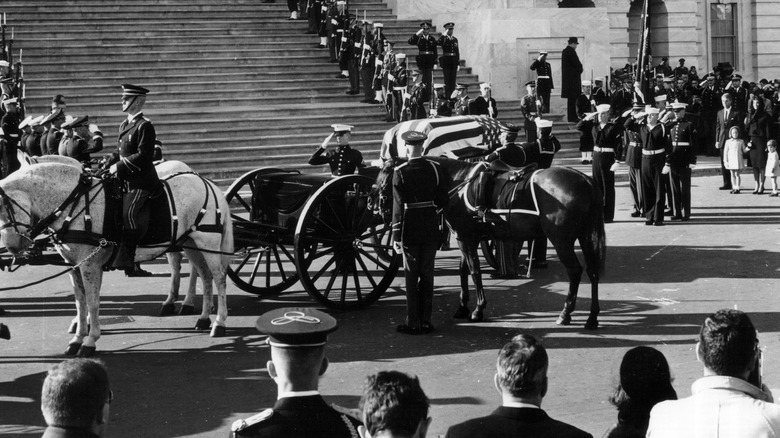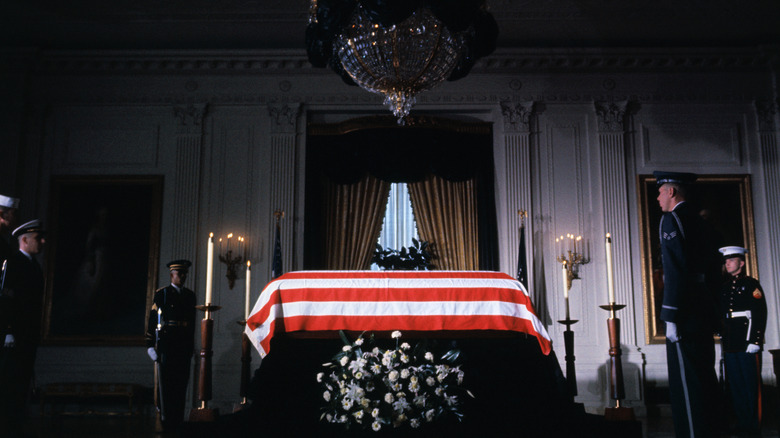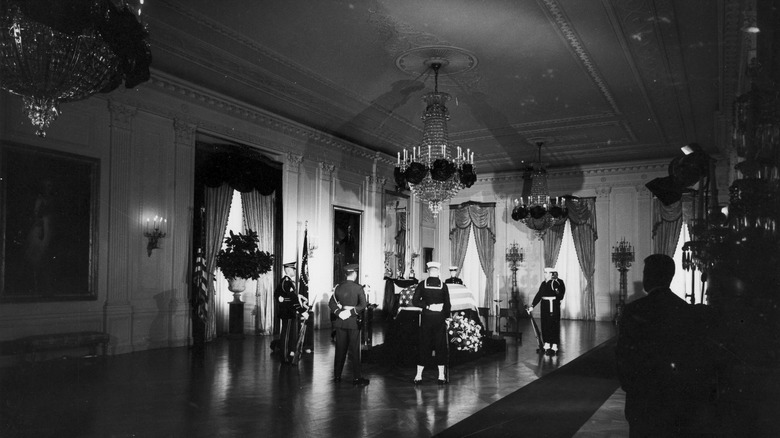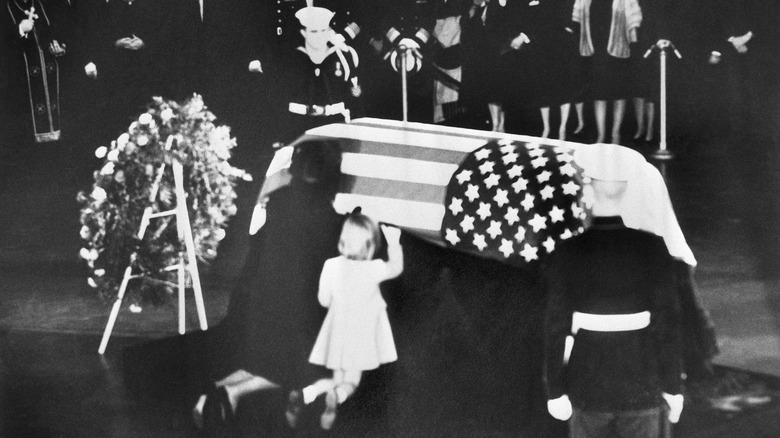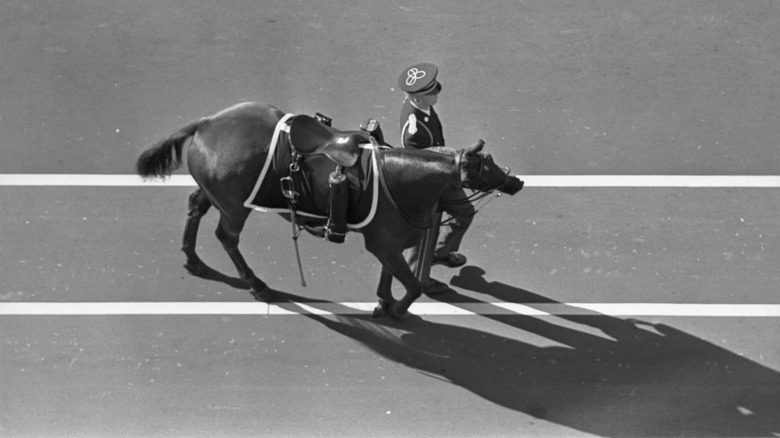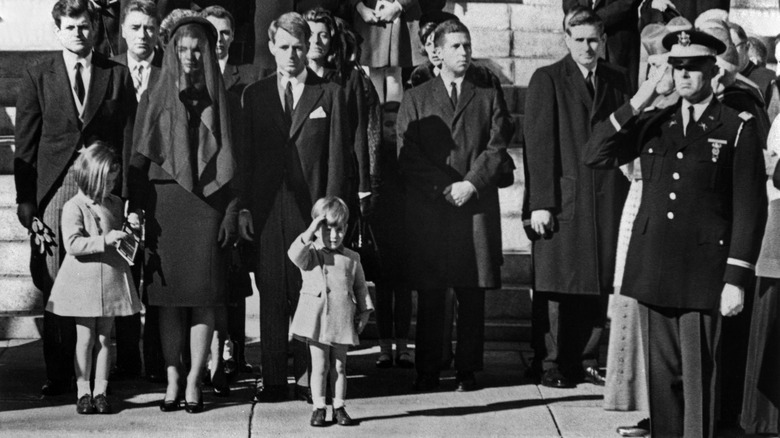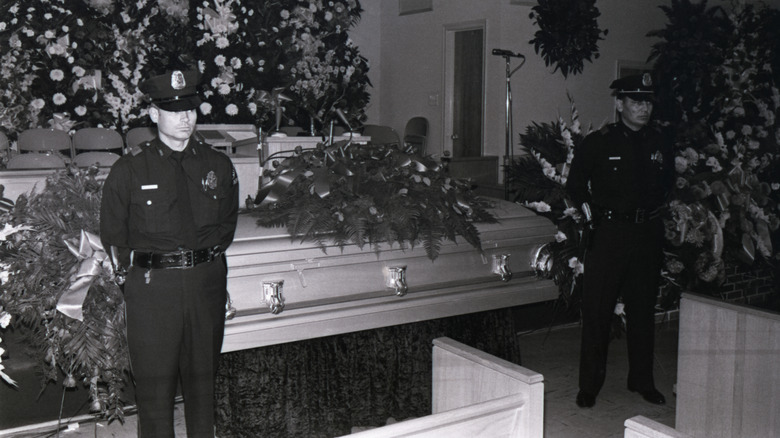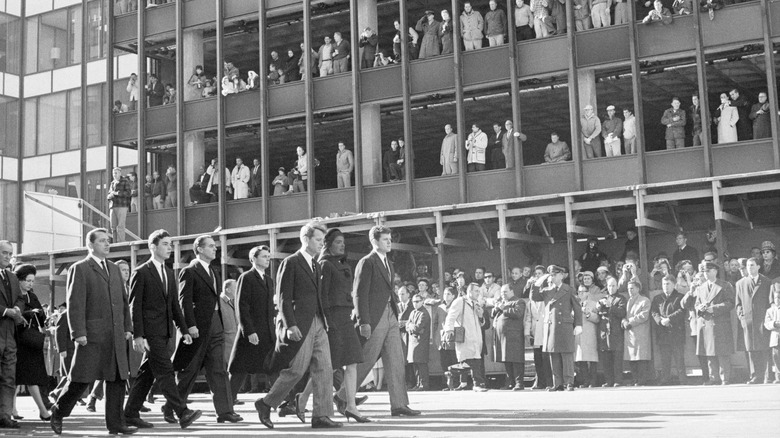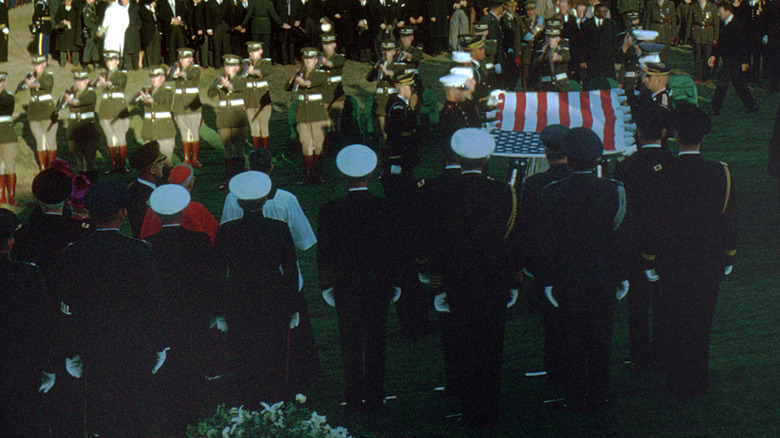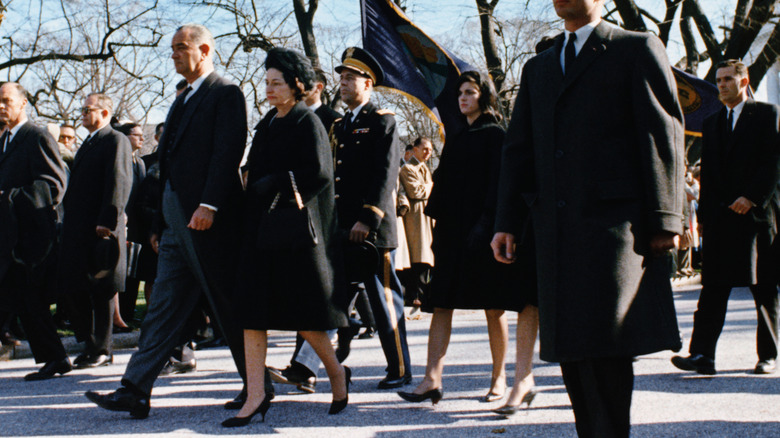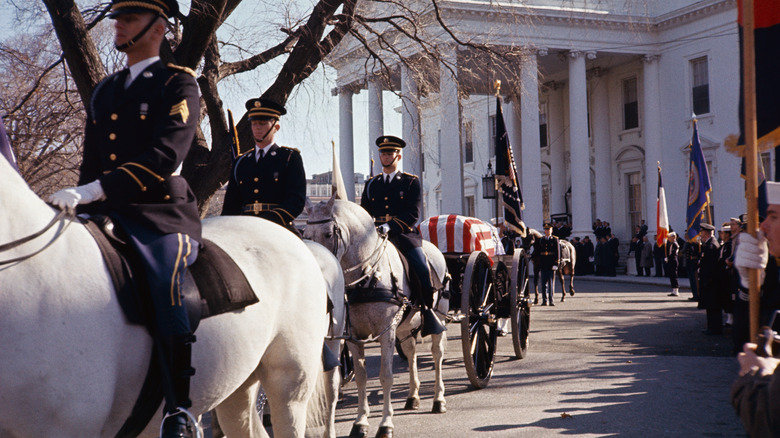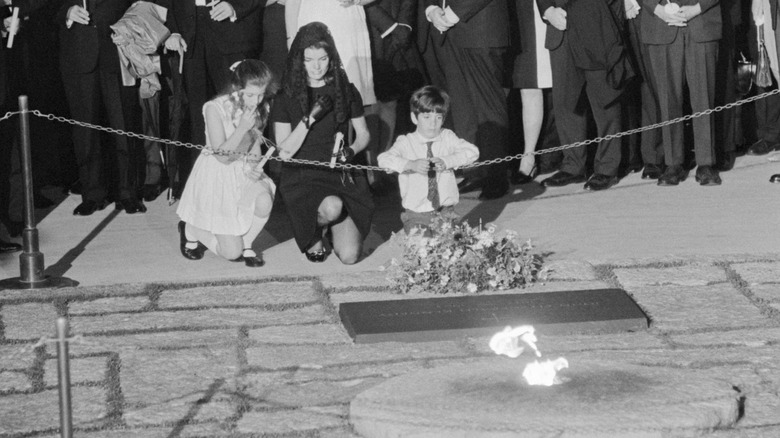What JFK's Funeral Was Really Like
One of life's more terrifying tendencies is that one where things change completely, terribly, and permanently, all in the blink of an eye. On November 22, 1963, that happened on a global scale with the assassination of American president John F. Kennedy: It was unexpected, it was unbelievable, and it sent shock waves across the world.
Long before news was shared instantly over the internet, it fell to the television networks to carry news of the assassination, the mad scramble for justice, and the funeral. It was such a big deal that many networks did something that seems at least slightly unthinkable: They canceled commercials, so they could broadcast uninterrupted, around the clock. And yes, the nation mourned, but so did the Kennedy family. Grief is a deeply personal thing, and no two people grieve in quite the same way. Jackie Kennedy found her grief put center stage in a global theater.
She later told Life, "Most people think having the world share in your grief lessens your burden. It magnifies it." Still, it was her very public farewell that was credited with guiding a nation that didn't quite know how to deal with televised tragedy, the assassination of a young, charismatic president, and the unknown that came next. JFK's widely-televised funeral took place over several days, and there were moments that the cameras didn't always catch.
The official funeral lasted for days
When President John F. Kennedy headed to Dallas for that fateful November day, no one expected that the following week would be taken over by his funeral. That said, it's worth noting that things actually happened pretty fast. JFK was shot at 12:30 p.m. on November 22 (Dallas time), pronounced dead at 1 p.m., and LBJ was sworn in about an hour and a half later. Although there's a general sort of outline that's followed for state funerals, it was Jackie Kennedy who insisted on several additions that were modeled after the funeral of Abraham Lincoln, including her decision to walk to the funeral mass.
Before that, though, JFK's body was rushed back to Washington, D.C. — and Jackie refused to change out of her bloodstained pink suit until the morning after the assassination, when she and JFK's casket returned to the White House's East Room. (That outfit has since been donated to the National Archives, but will not be displayed until at least 2103.)
JFK's casket left the White House two days to the hour after he was killed, taken to the Capitol Rotunda to lie in state for 21 hours. Somewhere around a quarter of a million people paid their respects in person, and then, the funeral procession — watched by around 800,000 people in-person — escorted him to the funeral mass at St. Matthews. After a ceremony lasting exactly one hour and 16 minutes, one of the nation's most enduring presidents was escorted to Arlington National Cemetery.
Jackie, Robert, and Secret Service agent Clint Hill were the last to see JFK
Not many people had the terrible, grisly, front-row seat to the assassination of John F. Kennedy that Clint Hill did: As a Secret Service agent on duty at that fateful Dallas parade, he was the one that famously jumped on the back of the presidential limo, pushing Jackie Kennedy back down into the little protection afforded by the back seat.
In his book, "Five Presidents: My Extraordinary Journey with Eisenhower, Kennedy, Johnson, Nixon, and Ford," Hill recounted the final time that JFK's casket was opened. He was in the East Room of the White House, he recalled, when Jackie and his brother, Robert Kennedy, requested that the honor guard step away for a moment and the flag be pulled back so they could see him one more time. Hill recalled opening the casket and stepping back even as Jackie asked him to find her a pair of scissors: He did, listening to her tears as she cut a few locks of hair. It was Robert who closed the casket that final time, then escorted her out of the room.
Hill wrote: "General McHugh and I checked the casket to make sure it was securely closed, and out of habit I looked at my watch to take note of the time — 12:46 p.m. I had seen President Kennedy for the last time; the casket would never be opened again."
The casket was always closed, but not for the obvious reason
An open casket is one of the most traumatizing parts of any funeral where the practice is observed, but for the entirety of JFK's funeral — even the private mass conducted only for the family — His casket remained closed but not for the seemingly obvious reason that Kennedy's assassin had aimed for his head.
According to The New York Times, the real reason that Jackie Kennedy ordered her husband's casket to remain closed was to remain in line with emerging Roman Catholic beliefs. The idea was rooted in the idea that after death, the body was nothing more than an empty shell, and the spirit had moved on to eternal life elsewhere. Actually viewing the body after death was thought to be little more than a distraction that encouraged mourners to focus on what had been lost in the physical realm, instead of what awaited in the spiritual one: Hence, JFK's casket remained closed.
JFK's symbolic riderless horse was nearly uncontrollable
One of the most iconic sights of John F. Kennedy's funeral was also among the oldest. The riderless horse, boots turned backward in the stirrups, harkens back to a time when horses were sacrificed to accompany their riders into the afterlife. For JFK, that horse was an Army Quartermaster-issued gelding named Black Jack, and on the day of JFK's funeral, he was anything but docile.
Black Jack and his handler, Arthur Carlson, escorted JFK throughout the funeral parade, and not only did the crowds and the sound of a grate being dragged along the pavement completely spook him, but he danced, pranced, and pawed for miles. Carlson was unable to do anything, as protocol dictated he basically stay silent and keep walking, with 1,200 pounds of pent-up panic beside him. Carlson's discipline is impressive, and even more so when it's taken into account that along the way, Black Jack actually stomped on his foot outside St. Matthews. He recalled to 12 WSFA, "I was actively afraid that the horse would get away from me."
Jackie Kennedy didn't forget his service, either, and bought Black Jack when he retired from military service. Never a riding horse, he retired in 1973 and died in 1976. His longtime human companion, Nancy Schado, described his uncharacteristically difficult behavior on the day of the funeral as something deep: "He wasn't used to assassinations. He was showing his objection to what happened. Animals sense things."
The story behind that iconic photo of JFK Jr.
Among those saying goodbye to John F. Kennedy on that bleak November day were his children. As if that famous photo of little JFK Jr. saluting his father's casket one last time isn't heartbreaking enough, consider this: It was his third birthday.
Stan Stearns (working for the United Press International) and Dan Farrell (for the New York Daily News) were the only two photographers that snapped that iconic moment, and when Stearns passed away in 2012, The Washington Post ran a retrospective of the funeral with his obit. Largely unseen by those who watched the funeral on television was the press box, with around 70 photographers crammed into an area measured for a few dozen, all trying to get photos of the funeral procession. And many didn't even see little JFK Jr.'s final goodbye.
"As the caisson was rolling out to Arlington Cemetery, I asked every photographer I could if they had the salute. Duh! Nobody saw it. Everyone I talked to had been concentrating on Jackie and the caisson." Stearns, however, had seen Jackie pause to say something to her young son, and with the forethought that makes a really, really good photographer, he kept his camera on the little boy. "One exposure on a roll of 36 exposures," he reflected later.
Two other funerals were on the nation's collective mind
As JFK's casket was being taken from the White House to the Capitol, "Four Days; The Historical Record of the Death of President Kennedy," United Press International recorded the mood when news broke of the assassination of gunman Lee Harvey Oswald: "Word of this new act of violence spread rapidly, adding a note of incredulous shock to the mood of mourning."
For countless people watching coverage of the funeral and the developing story of the assassination at home, the word didn't need to spread — they saw it happen. When Jack Ruby shot and killed Oswald on live television, it became the first real, televised homicide — and millions of people were watching. Oswald was buried the next day — the same day JFK was buried — and there were so few people in attendance that some of the reporters covering the funeral had to step in to carry the casket.
Also buried on the same day was Dallas police officer J.D. Tippit, who had spotted Oswald about 45 minutes after JFK was killed. When he approached to question him, Oswald shot and killed him. Around 1,500 people turned out to his funeral that afternoon (pictured), and it's safe to say that while Jackie Kennedy was burying her husband a few states away, Tippit was in her thoughts. She later sent his widow a framed photo of the Kennedy family, writing, "There is another bond we share. We must remind our children all the time what brave men their fathers were."
The nation went silent
People are, by their very nature, pretty loud most of the time, but when around 250,000 mourners converged on Washington, D.C. to pay their final respects to JFK, one of the things witnesses reported was the silence. In "Four Days," United Press International documented the quiet crowds, lines of people that stretched for miles, but remained silent: "As they turned to look at the flag-covered coffin, [mourners] seldom showed tears, and most had a kind of blankness."
The silence of the crowd was compared to a silence that had settled over the city during another presidential funeral. An 1865 newspaper report documenting Abraham Lincoln's funeral was reportedly one that could have been written about Kennedy's: "The ... procession, with a slow and measured tread, moved from the home of mourning on its mission with the remains of the illustrious dead. Despite the enormous crowd, the silence was profound."
The entire nation joined in on that silence to a certain extent. Nielsen reported (via Reuters) that 81% of homes with a television were watching the funeral. When surveys were conducted later, the majority of people who watched the funeral reported having a physical reaction to it, and perhaps an even better measure of how the nation mourned along with the Kennedy family was when the televisions were turned off. A massive drop in viewers was noted at the same time that JFK's funeral mass started: America, it seemed, had gone to their own religious sanctuaries, and prayed.
The Irish funeral drill
Jackie Kennedy had a few requests when it came to her husband's funeral, and with one, John F. Kennedy became the only U.S. president to have a foreign military presence at his graveside. That foreign military was Ireland, and getting there was no small challenge. When cadets at a County Kildare barracks were issued an invitation to come and perform a centuries-old, deeply meaningful drill at JFK's grave, they were out on a short leave. Summoned back from as far away as Dublin, they had hours to prep the Queen Anne Drill, once used to honor 17th-century soldiers, which had so impressed JFK when he'd seen the previous class perform it just months before his death.
After practicing for an hour, they grabbed some sleep, hopped on a plane (rifles stowed under their seats), and were met by the Secretary of State on the other side. And when they got to the funeral, it wasn't what they expected.
James Sreenan — who went on to become the Chief of Staff for the Irish Defence Forces — told The Irish Examiner, "We were told that you're going to carry out the drill at the graveside," he said, but as Irish and American funeral traditions can be pretty different, it wasn't clear to the cadets what they were being asked to do, especially given the fact that they knew the U.S. Army was going to be there front and center. Sreenan recalled: "It was an absolute shock that we were standing right at the graveside."
For LBJ, it was a chance to meet with leaders face-to-face
It's hard to imagine how that week must have felt to Lyndon B. Johnson, as he went from JFK's second to the president of a grieving and shocked nation. Even as he appeared in public alongside other mourners and mourned himself, behind the scenes, it was a bit of a different story. In his memoir, "The Vantage Point: Perspectives of the Presidency," Johnson wrote that he had immediately considered himself fortunate that JFK had always included him in foreign affairs discussions, and kept him up-to-date.
That said, the funeral was attended by scores of world leaders — and for Johnson, it was a time to watch, observe, and talk to them for the first time as president. Some meetings were incredibly strained: When France's Charles de Gaulle landed in D.C., it wasn't long after making comments that the U.S. couldn't be depended on, especially if European countries found themselves at war with the Soviet Union.
He wrote, "Like every American, my own spirit was heavy with grief; but the work had to go on. ... those days were marked by a strange counterpoint. There was the frenzied pace of meetings and briefings held behind closed doors, then the measured cadence of the funeral march; there was the harsh glare of office light burning deep into the night, then the somber hush and the dim, soft light in the East Room from the four large candles flanking John Kennedy's coffin."
There were fears of another assassination attempt at the funeral
In his memoir, "As I Saw It," then-Secretary of State Dean Rusk wrote about the chaos of not only arranging a funeral but making sure everything went according to plan even as they feared this was just the beginning of more troubles. Some leaders were viewed as more at-risk than others: "We were especially concerned about French President Charles de Gaulle's personal security during the Kennedy funeral," he wrote. "Political tensions were high in France, resulting in threats to his personal safety."
George Ball was the Under Secretary of State at the time, and in his memoir, "The Past Has Another Pattern," he echoed Rusk's fears. In addition to fears of a larger plot, there was also the reaction to consider: Would extremist groups take matters into their own hands? Ball also mentioned concerns that de Gaulle would be a target, along with leaders from the Soviet Union.
Concern was so great that Ball didn't attend the funeral at all: He wrote that he was instead tasked with standing by as the first line of defense if there was another assassination attempt or other political emergency. He was actually fine with it: "I have a distaste for the pomp and panoply of state funerals," he wrote. "We were treating the dead President as a king, rather than as a warm, human, lively, glittering young American elected by the popular vote of a great nation."
The eternal flame was built shockingly fast
The eternal flame remains one of the most powerful symbols of John F. Kennedy's impact on the U.S., and it was first lit at his funeral. The moment was somber and just as powerful as the imagery of it, but behind the scenes, it had been a wild scramble to get the temporary flame installed.
It came together thanks to the U.S. Army Corps of Engineers, and it doesn't get more last-minute: Inspired by Paris's eternal flame at their memorial to the Unknown Soldier, Jackie Kennedy asked for an eternal flame for JFK's grave... the day before he was buried there. According to Lt. General Walter K. Wilson Jr.'s book, "Engineer Memoirs," (via the U.S. Army Corps of Engineers), the hurried work was done from scratch even as the lying-in-state had begun. The flame was cobbled together — there wasn't even time for plans to be drawn up — and was based around a propane tank and a tiki torch. Thirty hours and one test-lighting later, Jackie lit the eternal flame.
Wilson wrote about feeling grateful that he'd been a part of the task, as it had been an important addition to the proceedings. He noted, "Little things like that helped ease the pain." Col. Clayton B. Lyle — who made the torch — echoed those sentiments, saying it was one of the most important moments of his decades-long career: "I considered it an honor to be a part of it, but I'd rather not have had to do it."
